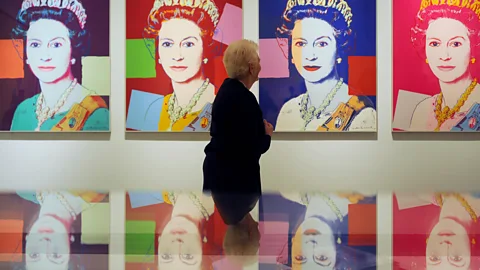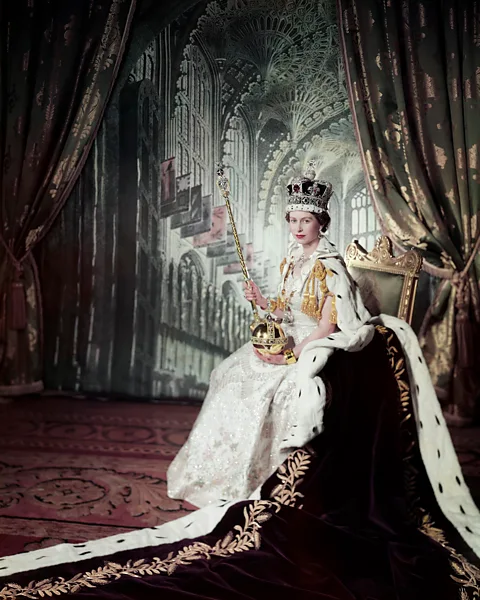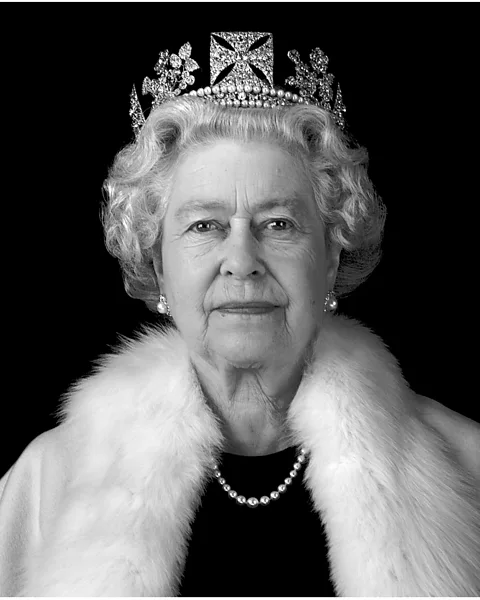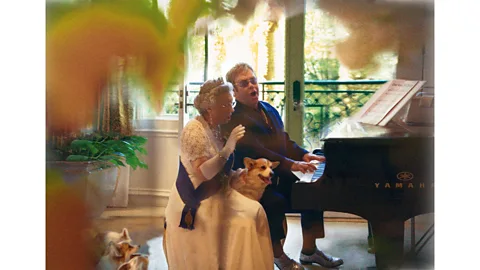The art that captured a Royal icon
 Alamy
AlamyFrom fairytale and formal to satirical and subversive – the art and photography that depict Her Majesty the Queen reveal some interesting truths. Holly Williams takes a look.
When Cecil Beaton photographed Her Majesty the Queen to mark her Coronation, in 1953, it was – as you might expect – in full pomp, with orb and sceptre, crown and robes, her golden throne standing tall amid the grandeur of Westminster Abbey… Except, well, it wasn't. The backdrop is fake; a mere image of the place where she was crowned queen. The picture was actually shot in a room at Buckingham Palace, with Westminster Abbey represented by a theatrical cloth: a stage set on which the Queen plays her part.
More like this:
Looking at it today, it seems faintly preposterous – a fairy-tale image, the backdrop something that could practically have come out of an early hand-painted Disney film. But it's also the perfect set-up for the monarch's lifetime of being photographed and painted – its very unreality both elevating and protecting her.
Despite having sat for hundreds of official portraits – and inspiring countless unofficial artworks – the Queen remains inscrutable: a pure performance of a role. We think of the art of portraiture as being about capturing some essence or intangible, defining character, yet portrait after portrait of the Queen fails to deliver any revelation. There's never been a true public "a-ha!" moment, when we think we see the woman behind the crown.
 Cecil Beaton/Camera Press
Cecil Beaton/Camera PressOf course, there are candid snaps that capture fleeting, unstaged moments – witness Patrick Lichfield's lovely, sunny photograph of The Queen on board HMY Britannia (1972), where she's laughing at the fact that he's being dunked in a pool (waterproof camera cannily in hand), or Mark Stewart's hilarious image of her recoiling from scones, The Queen is taken by surprise as she takes tea with Eton schoolboys at Guards Polo Club (2003). But when it comes to formal portraiture she remains, well, formal.
And Her Majesty is no doubt well trained in this: after 70 years of dutiful public service, of following what now feel like old-fashioned protocols, it's perhaps unsurprising that she doesn't want to let her guard down for some artist.
The Queen doesn't need to be #relatable: she continues to often be pictured in full regalia, like some sumptuous suit of protective armour, its theatrical grandeur a reminder that she is not like us, and nor, perhaps, should we wish her to be. Certainly, this pageantry is something it seems many portraitists can't resist, be that in Annie Leibovitz's glossy, moody, sumptuous series from 2007 or Julian Calder's Queen of Scots, Sovereign of the Most Ancient and Most Noble Order of the Thistle and Chief of the Chiefs (2010). That's another out-there fairytale look, the Queen standing in the midst of Scottish heather in a huge emerald velvet cloak, staring fiercely off into the distance. It is fabulously dramatic, and could be a still from Game of Thrones – but it is the opposite of humanising.
Even Lucian Freud's divisive 2001 portrait, a typically fleshy, squashy thing, has the Queen firmly in a tiara. The painting was widely criticised in the press, The Sun opting for the headline "It's a Travesty Your Majesty", while Robert Simon, editor of the British Art Journal, offered the deathless assessment that "it makes her look like one of the royal corgis who has suffered a stroke". For Adrian Searle, The Guardian’s art critic, however, it was the best royal portrait for "at least 150 years". He wrote that "portraiture is supposed to get beneath the skin; Freud has got beneath the powder, and that itself is no mean feat". Even in praise, there was a recognition that probably our then greatest living painter could only get beneath the monarch's make-up – not actually to what was on the inside.
 Jersey Heritage Trust 2004
Jersey Heritage Trust 2004To my mind, the two pictures that get closest to hinting at an interior life have one very unusual thing in common: the Queen has her eyes shut. Chris Levine's 2004 holographic portraits show the usual pomp and poise – but it is an image caught between formal shots, eyes closed, that arrests the viewer. It's genuinely beautiful, utterly radiant, but it also carries a rare sense of authenticity: here is the private Queen, one who momentarily has gone inwards. "I wanted the Queen to feel peaceful, so I asked her to rest between shots; this was a moment of stillness that just happened," Levine told The Guardian in 2009. "This picture takes us into the Queen's mind, her inner realm."
The other is not a formal portrait, but still notable nonetheless: Mark Stewart's photograph, The Queen Crying at the Field of Remembrance, Westminster Abbey from 2002. It captures a rare instance of the Queen showing vulnerability and emotion, during a ceremony previously always carried out by her mother, in the year after she died. Yet even this image reveals an attempt to retain control, surely, via the act of her shutting her eyes. It is striking that even in the two images that feel most "real", the viewer is still not allowed full access. If eyes are the window to the soul, the Queen has drawn the curtains.
Queen and country
The tight control of the Queen's official image has resulted in its own interesting side effect. The Queen doesn't seem like a real person to us: she has become, instead, a symbol. A highly codified image, instantly recognisable. Portraits of her might fail to show a human being – instead (and you suspect this may be exactly what she's hoping for) they turn her into a pure icon. And artists love icons. Many of the most recognisable images of the Queen are not polite portraits – but rather works that use her image in subversive, witty, or irreverent ways. This only works if an image is well-known enough to riff on, of course – and Her Majesty certainly is. Having that neat little image on millions of stamps and coins for 70 years obviously hasn't hurt; her profile is apparently so identifiable that British stamps are the only ones in the world that don't need their country of origin spelled out.
But this has also allowed the Queen's image to symbolise all sorts of contradictory things: a visual shorthand that can be used either to celebrate or critique Royalty, privilege, power; Britishness or Englishness or empire; tradition, endurance, the stiff-upper-lip… but also a certain kitsch, camp, or bling. Artists use her to say whatever it is they want to say, or as a rich canvas for their style, their aesthetic; they do not to try to accurately represent her as a person. As such, a history of unauthorised images of the Queen offers almost a crash-course in various trends of contemporary art.
Think of Andy Warhol giving Elizabeth II the silk-screen, colourful Pop Art treatment in 1985, proving she's as iconic as Marilyn Monroe, Chairman Mao and Campbell's Soup. Or Jamie Reid's infamous 1977 collages where Liz goes punk, a safety pin through her lip, indelibly associated with the Sex Pistols' anti-monarchist God Save the Queen.
 Alison Jackson Artist, London www.alisonjackson.com
Alison Jackson Artist, London www.alisonjackson.comGeorge Condo's 2006 painting, Dreams and Nightmares of the Queen, is grotesquely cartoonish, and doesn't really bear any resemblance to the monarch – it was dubbed The Cabbage Patch Queen for resembling those hideous squashy 1980s toys – but the set hair and robes mean we'd guess who it was even without the title. This is the Queen as an artist's plaything.
More recently, street artists including Banksy and Pegasus have cop-opted her image. In an unusually apolitical and un-critical stencil mural in Bristol in 2012, Banksy mashed Ma'am up with fellow icon David Bowie via a Ziggy Stardust-style lightning-bolt makeover. Meanwhile Pegasus cast her as a pin-up girl, coyly posing in front of a pastelised Union Jack (is it notable it's in the colours of the Trans pride flag?) on a north London pub door in 2015. Yet, like many appropriations of the Queen, there's a big dollop of affection in such high-camp reinventions. And these depictions are perhaps less about the Queen herself, than they are about celebrating a certain irreverent sense of Britishness.
There's both cheek and affection in Alison Jackson's photographs and films of Royal lookalikes too – titillating the viewer by seeming to suggest that Mrs Windsor enjoys a flutter at the betting office, takes selfies with the grandkids, and has a sing-along at the piano. There's a cosy humour in the suggestion that she's just like us, after all – something her official portraits have certainly never achieved, or possibly even attempted.
Even more mischievous – or cruelly provocative; take your pick – is Kim Dong Yoo's enormous 2007 portrait. What looks like a blurred or pixelated image of the Queen is revealed, on closer examination, to be made up of hundreds of tiny hand-painted images of… Princess Diana. Its title? Elizabeth vs Diana.
This mention of Diana might lead us on to the other thing that makes the Queen a pure visual icon: the fact that she is probably the last in the line of Royal icons. Diana would be the only other Royal that got close, her image adored and venerated, still the subject of exhibitions just about her appearance – but her death was too tragic to really allow her face to be used in as light-hearted a way as the Queen's sometimes is.
As for the rest of them… we know too much about Charles, William, Kate and other Royals for them to take on the Queen's mantel in this respect. She might have retained her unknowability and her dignity in an era of over-share – but her family members are like reality TV stars, their every move documented and analysed. We think we know them, their personalities and flaws. Elizabeth II will surely be the last Royal ever to be so well-known, yet so little-known.
 Alamy
AlamyAny artistic portrayal of Prince Charles has to wrestle with all the stuff we associate with him – it can't just be kitsch. You wouldn't reach for Kate's image unless you had some point to make about, say, press intrusion or contemporary expectations of femininity; the column inches dedicated to her and her family and her "rivalries" with Meghan Markle mean she's hardly a blank canvas in the way that, actually, the Queen strangely still can be.
It's also unlikely that the next monarch, at the very least, will have such a long reign; brutally, Charles is not going to have enough time on the coins and stamps to become iconic. Whereas the Queen has reigned through, and been used as an image within, seven decades of enormous change – a fact that is reflected in how she is used in visual art, her image rippling through changing trends, in a way that we are also unlikely to see again with another figurehead any time soon.
I am sure artists will continue to depict the Royals, but I suspect interpretations of them will be more about making comment on the monarchy or modern society – either affectionate or subversive or critical. They are less likely to become a globally recognised, singular, codified visual icon. It will surely be the Queen's image that continues to reign over us.
Holly Williams’s novel What Time is Love? is published by Orion on 26 May.
And if you liked this story, sign up for the weekly bbc.com features newsletter, called The Essential List. A handpicked selection of stories from BBC Future, Culture, Worklife and Travel, delivered to your inbox every Friday.
